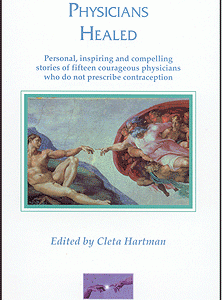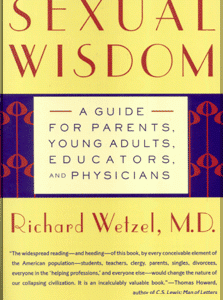Sterilization
Homosexual Marriage: We Have Sown The Wind, And Now Reap The Whirlwind.
 by Msgr. Charles Pope
by Msgr. Charles Pope
Homosexual Marriage Is The Logical Conclusion For A Culture That Celebrates Sterility! Widespread Acceptance of the Homosexual Lifestyle Is God’s Punishment for Sin!
There is, among faithful Catholics, a dismay, and even an understandable anger at the events unfolding at the Supreme Court these past days related to gay unions. And even if the court were to uphold traditional marriage (which does not seem likely), or merely return the matter to the States, it seems quite clear where our culture is going regarding this matter, approving things once, not so long ago, considered unthinkable.
What then to do with our dismay and anger? It is too easy to vent anger, which is not only unproductive, but in the current state of “hyper-tolerance” for all things gay, angry denunciations are counter-productive. (more…)
Vasectomy Safe and Simple?
 by
by
Liliana Cote de Bejarano, MD, MPH
About 1.5 million couples in the United States opt for sterilization every year .1 According to the Guttmacher Institute, 9.9% of couples in the US use vasectomy as a contraceptive method, and more than 500,000 vasectomies are performed in the United States every year.2 The medical community and most family planning advocates consider vasectomy safe and simple. This pamphlet provides current research on vasectomy that indicates the procedure has a number of short- and long-term complications and is not a healthy choice.
What is required for fertilization?
The Hurtful Consequences of Artificial Contraception and Sterilization: Three Personal Testimonies
Rick and Peggy
In 1971, my husband and I were married. Thinking birth control must be okay because no one had said anything against it during my high school years and I had never heard a homily addressing the issue, I made an appointment with my family doctor. I asked if I needed to be on a stronger birth control pill, since now I would be taking it for the purpose of birth control instead of acne. He prescribed the pill and off I went.
We used contraceptives for the next three years. Our lives became very selfish and self-centered, as they caused us to become very empty and lonely. We thought, “There is more to life than this.” We had a strong yearning to have a baby and thought this was the right time. (more…)
Dear Rick: A personal letter to my husband, lover, and best friend
Dear Rick,
If someone would ask me, “How’s your love-life?” I would say, “Beautiful, Awesome and Wonderful!” But in the past I wasn’t always able to say those words.
When we used contraceptives the first few years of our marriage, I felt an emptiness. Something was missing! I felt used! Remember when I would share with you how I couldn’t feel close to you, but I didn’t know why I felt this way!
We felt an emptiness and wanted to have children. So I stopped taking the birth control pills, but couldn’t conceive. The birth control pills had been a detriment to my physical health and the doctor told us surgery was necessary to resolve the problem they had caused. (more…)
Dear John: A Personal Letter to my Husband, Lover, and Best Friend
Dear John,
Almost 22 years ago we took an oath before God, family and friends to lovingly accept children. This was a commitment we looked forward to, but it was also a concern because I have diabetes.
In ten years of marriage, God blessed us with three beautiful children, but all were very complicated pregnancies with toxemia and uncontrollable blood sugars. Through it all, you were my strength – even during the cesarean births, you stood by my side. (more…)
Female Sterilization
What Every Woman Should Know about
-Tubal Ligation
-Sterilization by Tubal Inserts
-Sterilization Reversal
What is female sterilization?
Female sterilization means making a woman permanently infertile, usually by cutting, tying, or blocking her fallopian tubes.
What are the fallopian tubes?
The fallopian tubes are two organs situated sideways in the lower abdomen attached to the uterus. They conduct the ovum from the ovaries toward the uterus and also nurture the ovum and the sperm. If fertilization occurs, the fallopian tubes nurture and transport the human embryo to the uterus.

What is tubal ligation?
Tubal ligation involves closing off the fallopian tubes by cutting, burning, tying, or fastening a clip (or a combination of these methods) to cause permanent sterility (infertility). It is a surgical procedure carried out under anesthesia.
Two common surgical procedures for getting one’s “tubes tied” are:
Laparoscopy: Usually small incisions are made in the lower abdomen. Carbon dioxide gas is pumped in to inflate the abdomen, and a fiber-optic light is inserted. Then, surgical instruments are insertedto cut, tie, or burn the fallopian tubes.
Mini-laparotomy: This procedure requires a small incision in the lower abdomen. The fallopian tubes are closed by clips, burned, or cut and tied.
What is non-surgical sterilization?
There is a new non-surgical method of permanent female sterilization. In a procedure called hysteroscopy, micro-inserts are passed through the vagina, cervix, and uterus, and placed in the fallopian tubes. The micro-inserts cause a tissue barrier to form that prevents sperm from reaching the egg.
Does female sterilization have health risks?
Risks from anesthesia and surgery
- Infection1
- Bleeding2
- Respiratory problems
- Adverse effects from anesthetics
- Damage to abdominal organs3
- Bowel perforation4
- Death
Risks from tubal ligation itself
- Menstrual disorders5
- Ovary dysfunction6
- Ectopic pregnancy7
- Remorse8
Long-term psychological effects such as depression and anxiety have been reported by women after tubal ligation.9 Stress interfering with sex has been reported in women after tubal ligation.10 The probability of undergoing hysterectomy within 14 years after sterilization is 17% per 100 procedures.11
Is sterilization 100% effective?
NO. Failure rates can range from 1% for laparoscopic sterilization up to 13% for hysteroscopic sterilization.12 When pregnancy occurs after a female sterilization procedure the risk for ectopic pregnancy is 7.3 per 1000 procedures and can be higher for the newest procedures.
Warning! Sterilization does not protect against
sexually transmitted diseases including AIDS.
What if I change my mind?
Many sterilized women later desire to have their fertility restored. Some have entered new relationships and want a child with their new partner; some want a return to physical wholeness; some believe that they have done something immoral and are seeking spiritual restoration. There are, however, significant obstacles to sterilization reversal; for example, the surgery is more extensive and expensive than the original procedure, and it is typically not covered by insurance. Also, a return of fertility is not guaranteed; the success rate varies depending on a woman’s age, the type of sterilization performed, and the skill of the surgeon.
Is sterilization morally acceptable?
Before 1930 no Christian church accepted sterilization or any form of contraception. The Catholic Church and some Protestant churches still teach that intentional sterilization is an immoral form of birth control.
What are my options?
If you are married, the modern methods of Natural Family Planning (NFP) are the safest, healthiest, and least expensive alternatives for family planning.
If you are single, abstinence is the best option and always works!
References
1. Levgur M, Duvivier R. Pelvic inflammatory disease after tubal sterilization: a review. ObstetGynecol Surv. 2000 Jan; 55(1): 41-50.
2. Magos A, Chapman L. Hysteroscopic tubal sterilization. Obstet Gynecol Clin North Am. 2004 Sep; 31(3): 705-19, xii.
3. Moore CL, Vasquez NF, Lin H, Kaplan LJ. Major vascular injury after laparoscopic tuballigation. J Emerg Med. 2005 Jul; 29(1): 67-71.
4. Westhoff C, Davis A. Tubal sterilization: focus on the U.S. experience. Fertil Steril. 2000 May; 73(5): 913-922.
5. Timonen S, Tuominen J, Irjala K, Maenpaa J. Ovarian function and regulation of thehypothalamic-pituitary-ovarian axis after tubal sterilization. J Reprod Med. 2002 Feb; 47(2): 131-136.
6. Holt VL, Cushing-Haugen KL, Daling JR. Oral contraceptives, tubal sterilization, and functional ovarian cyst risk. Obstet Gynecol. 2003 Aug; 102(2): 252-258.
7. Jamieson DJ, Hillis SD, Duerr A, et al. Complications of interval laparoscopic tubal sterilization: Findings from the United States Collaborative Review of Sterilization. Obstet Gynecol. 2000; 96: 997–1002.
8. Kelekci S, Erdemoglu E, Kutluk S, Yilmaz B, Savan K. Risk factors for tubal ligation: regret and psychological effects impact of Beck Depression Inventory. Contraception. 2005 Jun; 71(6): 417-420.
9. Luo L, Wu SZ, Zhu C, Fan Q, Liu K, Sun G. Psychological long-term effects of sterilization on anxiety and depression. Contraception. 1996 Dec; 54(6): 345-357.
10. Warehime MN, Bass L, Pedulla D. Effects of tubal ligation among American women. J Reprod Med. 2007 Apr; 52(4): 263-272.
11. Hillis, SD, Marchbanks, PA, Tylor, LR, Peterson, HB. Tubal sterilization and long-term risk of hysterectomy: Findings from the United States collaborative review of sterilization. The U.S. Collaborative Review of Sterilization Working Group. Obstetrics & Gynecology. 1997; 89(4): 609-614.
12. Gariepy A, Creinin M, Schwarz EB, Smith K. Reliabilityof laparoscopic compared to hysteroscopic sterilizationat 1 year: a decision analysis. Obstet Gynecol. 2011; 118: 273–9.
Where can I learn more about Natural Family Planning?
One More Soul (OMS) is a non-profit organization dedicated to spreading the truth about the blessings of children, the harms of contraception, the benefits of Natural Family Planning, and the virtue of chastity. We carry a wide variety of educational resources, including tapes, videos, CDs, DVDs, and books. Natural Family Planning classes are available each month in English and Spanish.
Please call us or visit our web site www.OMSoul.com for more information about tubal sterilization reversal.

Female Sterilization
What tubal ligation is; the physical, mental and moral consequences that a woman should consider before making the serious decision to become sterile; and what alternatives exist







Sterilization Reversal Book 2013 Edition
The Theme of the Book
Sterilization Reversal – A Generous Act of Love is a compilation of 20 stories of couples who were sterilized and then sought sterilization reversal. It is the first book that discusses, from a Roman Catholic perspective, the destructive impact that sterilization has on marriage and the joyous spiritual and marital renewal experienced by couples after reversal. As such, Sterilization Reversal – A Generous Act of Love is a unique resource for clergy, religious educators and laypeople. It is an especially useful tool for the pastoral counseling of persons who have repented their sterilization. It is also a particularly effective means of informing people who are considering sterilization of the emptiness and heartbreak that often follow as well as the NFP alternative that nourishes the marital relationship rather than attacks it. (more…)
Posted in Featured, News & Commentary, Online Books, Publications, Sterilization | No Comments »